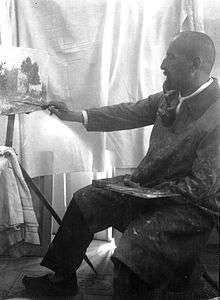Alexander Baerwald
Alexander Baerwald (1877–1930) was a German Jewish architect best known for his work in Haifa, Israel.
Alexander Baerwald | |
|---|---|
 Alexander Baerwald painting | |
| Born | 3 March 1877 Berlin, Germany |
| Died | 27 October 1930 Haifa, Mandatory Palestine |
| Nationality | German |
| Alma mater | Technische Hochschule Charlottenburg Technische Hochschule of Munich |
| Occupation | Architect |
| Spouse(s) | Lotte Eisenberg |
| Awards | Schinkel Prize |
| Buildings | Technion Campus, Haifa
Merhavia Anglo-Palestine Bank, Haifa Prussian Royal Library, Berlin Central Hospital, Afula |
_-_Facade.jpg)
Life and career
Baerwald was born in Berlin, Germany on 3 March 1877. He studied at the Technische Hochschule Charlottenburg (1897-1901), interrupted by the summer semester 1898 at the Technische Hochschule of Munich. From 1903 to 1927 he was employed with the Prussian Construction and Financial Direction of Berlin, responsible for public constructions in Berlin. He advanced to become a Royal Ministerial Construction Councillor (German: Königlicher Ministerialbaurat). One of his tasks was the construction management for the new building of the Prussian Royal Library (German: Königliche Bibliothek), in Berlin between 1908 and 1913. The building known for its Neo Baroque architecture, following a design of the popular Wilhelmine architect Ernst Eberhard von Ihne, adapted by Baerwald, is now the House I of the State Library at Berlin of Prussian Cultural Heritage (German: Staatsbibliothek zu Berlin - Preußischer Kulturbesitz), in Unter den Linden street. After designing several other structures in the capital in the early 1910s, including his own villa in Berlin-Dahlem (1912), he moved to Ottoman Palestine temporarily around 1912 where he began work in Haifa.
Baerwald is best known for designing the Technion University campus in Haifa, Israel between 1912 and 1924, for which he had been employed by the Hilfsverein der deutschen Juden (Relief association of the German Jews). He also designed the neighbouring building of the Beit Sefer haReali (German: Realgymnasium), a school to prepare pupils for a study at the Technion. Today the old Technion building forms part of the Israel National Museum of Science, Technology, and Space. He became a Professor of Architecture at the Technion throughout much of his later life and he made a significant contribution to the Prussian academic discipline in the country.
In 1915 he built the moshav of Merchavya after his designs. In 1924 he designed the Anglo-Palestine Bank department in Haifa, now operating as Bank Le'umi Le-Israel. He also designed numerous other buildings in Palestine, and in 1925 Baerwald had settled there permanently. There he was acclaimed for introducing academic architecture to the country. By the late 1920s he had designed the Central Hospital, Afula in 1928, and the Phillips House, in Haifa (1929–30) shortly before his death on 27 October 1930 in Haifa. He was buried at the Jewish cemetery on the Mount of Olives.
References
- A Dictionary of Architecture and Landscape Architecture, Oxford University Press.
- Myra Warhaftig (in German) (Hebrew: מירה ווארהפטיג), "Alex Baerwald", in: Sie legten den Grundstein. Leben und Wirken deutschsprachiger jüdischer Architekten in Palästina 1918-1948, Berlin and Tübingen: Wasmuth, 1996, pp. 34–41. ISBN 3-8030-0171-4